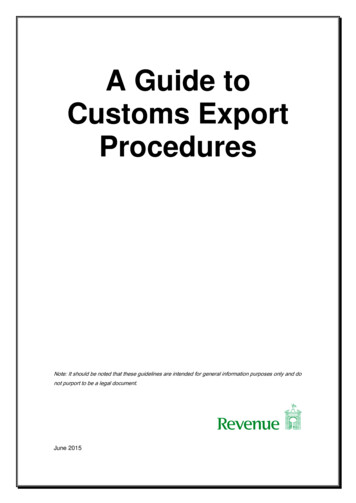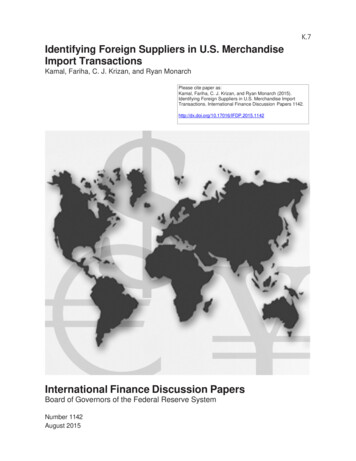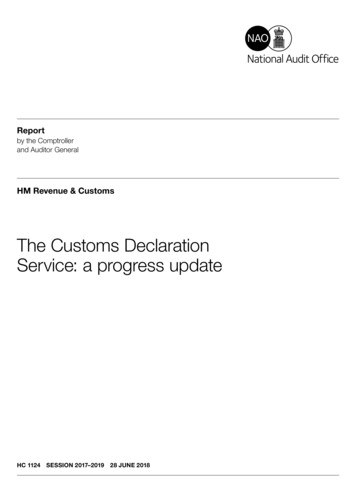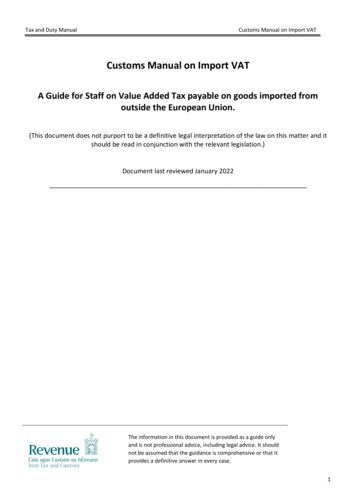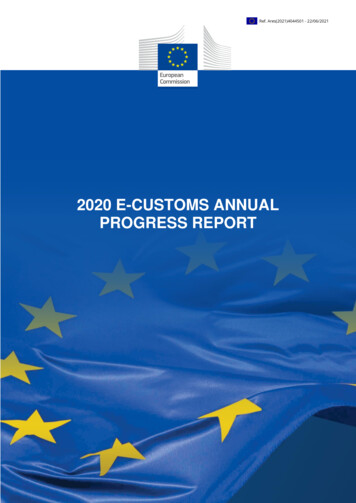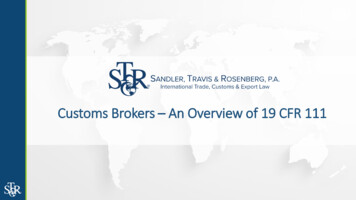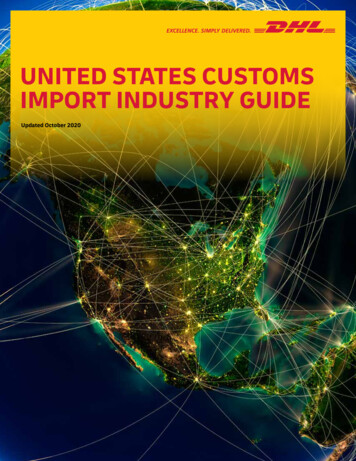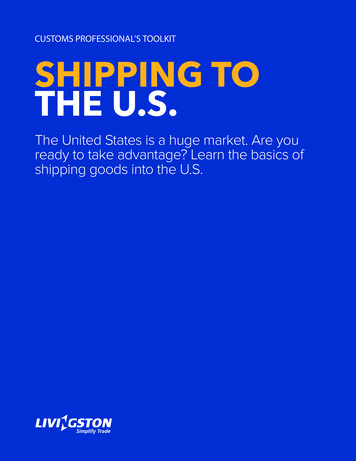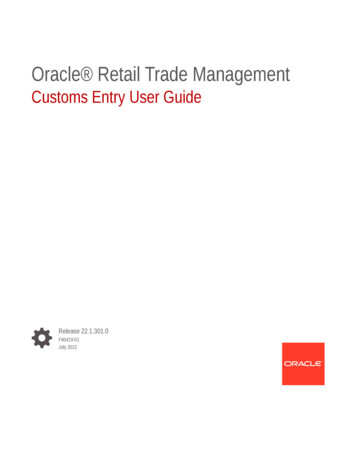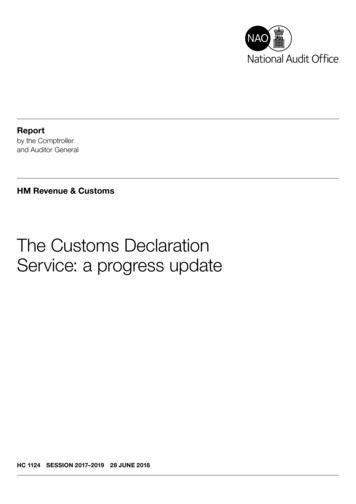
Transcription
A picture of the National Audit Office logoReportby the Comptrollerand Auditor GeneralHM Revenue & CustomsThe Customs DeclarationService: a progress updateHC 1124 SESSION 2017–201928 JUNE 2018
4 Key information The Customs Declaration Service: a progress updateFigure 1 shows Overview of customs declarationsFigure 1Overview of customs declarationsThe Customs Declaration Service (CDS) will process customs declarations from a variety of routes and will help to clear goodsto cross the border150,000Suppliertraders/suppliers who currentlydeclare customs to HMRCCustoms declared to HMRCby supplier using own orthird party software1 Supplier deliversgoods to borderport, often withthe assistanceof a freightforwarder,courier orcustoms agents145,000additional traders/suppliersexpected to declare customs after March 2019TransporterCommunity SystemProviders (CSPs)5 CSPs operate inventorysystems at ports and airportsInventoryand storagePort or airportauthority 820 billionofgoods traded across theborder in 2017Flow of goodsCustoms declarationNote1 This report focuses on HMRC's creation and implementation of a new Customs Declaration Service (CDS).Source: National Audit Office
The Customs Declaration Service: a progress update Key information 5Customs DeclarationService (CDS)at HMRC55 million customs declarationsmade in 2016-17255 million customs declarationsmight be made each year after March 20192 Supplier is responsible for makinga customs declaration but anintermediary may complete thison their behalf. Declaration may godirectly to CDS or via a CommunitySystem Provider (CSP) system atcertain ports and airportsCustoms declared to HMRC by intermediaryCustoms declared via CSP system at certainports and airportsCustomswarehouseHMRC andBorder Force7,670staffemployed by BorderForce in 2016-173 HMRC and Border Force inspect andclear goods as appropriate based onrisk profiling in CDS; they work with othergovernment departments for clearance ofspecific goods such as animal productsRequestingcompany4 Once customs arecleared, goodsare released fordelivery to requestingcompany or into acustoms warehouse.This allows traders tosuspend payment ofduty until the goodsleave the warehouse
6 Key facts The Customs Declaration Service: a progress updateKey facts255m150,000 145,000customs declarations thatHM Revenue & Customs (HMRC)estimates might be made after theUnited Kingdom (UK) leaves theEuropean customs union, around a200 million increase on the 55 millionexisting declarations each yearcurrent traders who makecustoms declarationsand will need to move tothe Customs DeclarationService (CDS) from theexisting systemminimum number of traderswhom HMRC estimatescurrently trade withinthe European Union (EU)and might make customsdeclarations for the firsttime after the UK leaves theEuropean customs unionCDS programme dates when we last reported in July 2017July 2018HMRC planned to finish building the full CDS scopeAugust 2018HMRC planned to start migrating traders to CDSJanuary 2019HMRC planned to complete migrating traders to CDSNew CDS programme datesAugust 2018HMRC aims to go-live with CDS and start migrating traders asplanned – it expects to have 44% of the full functionality in placeat this timeNovember 2018HMRC now plans to release remaining import functionsand start migrating traders who require these functionsDecember 2018HMRC now plans to release all export functions and startmigrating traders who require these functionsJanuary 2019HMRC now aims to complete migrating traders to CDS,however this may not be possible given the plan torelease export functionality one month beforeContingency programme datesJuly 2018HMRC plans to have demonstrated the CHIEF(Customs Handling of Import and Export Freight) system’scapacity as a contingency option. When we previously reported,HMRC had not planned its contingency option in detail
The Customs Declaration Service: a progress update Summary 7Summary1HM Revenue & Customs (HMRC) is now in the final year of its programme toreplace its existing customs system, CHIEF (Customs Handling of Import and ExportFreight), with a new Customs Declaration Service (CDS). The new system will be anintegral part of the UK’s overall customs regime. The UK collects around 34 billionannually from customs and excise duties and value added tax (VAT) on transactionsat the border. In 2017, around 820 billion of goods crossed the border. It is vital to theUK’s economy and consumers that trade continues to operate smoothly across theborder, for example by maintaining the trade flow of perishables such as food products.2HMRC is changing its customs system to comply with legislative requirementsthat were established before the UK voted to leave the European Union (EU). HMRCconsiders that the UK’s decision to leave the EU, the European single market andcustoms union have not changed the overall rationale for CDS. HMRC is still buildingCDS to comply with the EU legislation which is already familiar to industry, and theresulting system will comply with international rules.3There are around 150,000 traders who import and export goods outside the EU.These traders already make around 55 million customs declarations each year in CHIEF,predominantly through a third party. HMRC expects these traders to continue to makecustoms declarations in CDS. The UK’s decision to leave the EU and the customs unionhas important implications for the CDS programme. Depending on the outcome of EUexit negotiations, from March 2019: at least 145,000 traders who currently import or export goods solely within theEU might be required to make customs declarations for the first time; and the number of customs declarations could increase from around 55 millionto around 255 million each year.4On 19 March 2018, the government published a draft agreement on the withdrawalof the UK from the EU. The withdrawal agreement proposes an implementation period thatwill apply from 29 March 2019 until 31 December 2020. If the draft agreement is approvedand this preserves customs arrangements as they are, traders who operate solely withinthe EU will not have to submit customs declarations until after December 2020. As aconsequence, the assumption is that there would not be an associated increase in thevolumes of customs declarations until after this date. However, the draft agreement isbeing negotiated and HMRC, as with the rest of government, continues to plan for the UKleaving the EU customs union with ‘no deal’ and no implementation period.
8 Summary The Customs Declaration Service: a progress update5We first reported on the CDS programme in July 2017. We found that HMRChad made progress, but a significant amount of work remained to implement CDSsuccessfully. We concluded that government as a whole had to decide whether itneeded to do more to mitigate the risk of CDS being needed but not ready in time.6In October 2017, the Committee of Public Accounts (the Committee) took evidencefrom HMRC on its progress in implementing CDS. A summary of the Committee’sconclusions and recommendations, and HMRC’s responses, is included in Appendix One.Scope7This report provides an update on HMRC’s progress since July 2017. We considerthe deliverability of the CDS programme and highlight the risks and issues HMRC needsto manage to fully implement CDS by January 2019. We also consider what HMRC’sprogress with CDS and its contingency option means for the risks associated with beingunable to process customs declarations at the volume required in the event of ‘no-deal’with the EU. As in our previous report, we do not evaluate the overall value for money ofthe programme. We review: how HMRC is managing the CDS programme; HMRC’s progress in meeting the technical challenges of implementing CDSand creating a working contingency option; and HMRC’s actions to ensure that traders and others involved in customsadministration are ready to use CDS by January 2019.8This report does not cover aspects of the government’s overall customs regimethat are outside the CDS programme. In particular, we have not included: Border Force, which controls the movement of goods, people and transport atthe border, and the work of other government departments and agencies; and wider changes to border systems, infrastructure and any requirements for newstaff resources.
The Customs Declaration Service: a progress update Summary 9Key findingsProgress towards a functioning customs system on leaving the EU9HMRC has made progress in addressing risks within the CDS programme.In our previous report, we highlighted five significant risks that HMRC needed tomanage. These were: the very tight delivery timetable; integrating the CDS system withHMRC’s technology and ensuring it can handle increased volumes; managing CDS’sstakeholders, including the many traders who will use it; managing the CDS programmeand scope; and ensuring the programme is fully funded and resourced. Since ourreview, HMRC has secured all the funding it currently expects to require for CDS. It hasalso made some progress in tackling other risks and has put mitigations in place againstrisks that have subsequently arisen, alongside developing contingency arrangements.Nearly one year on from when we last reported, we set out the current programme risksand issues below (paragraphs 1.7 and 1.10 to 1.14, Figure 3 and Figure 4).10 HMRC has accelerated work on its contingency option for handling customsdeclarations in the event of ‘no deal’ in March 2019. In July 2017, we reported thatHMRC had identified contingency arrangements in case CDS was not ready on time,but had not planned these in detail. HMRC has now made progress with planning andimplementing contingency arrangements. These involve scaling up the existing CHIEFsystem to manage up to 255 million customs declarations each year. HMRC expectsthis to cost 8.7 million. When we first reviewed CDS, HMRC planned to complete thetesting required to demonstrate whether CHIEF can scale up by December 2018. It nowplans to do this by July 2018. HMRC expects it will take a further three months to scaleup the operational CHIEF system. If it successfully completes this work, HMRC shouldhave the system capacity to handle customs declarations no matter what the outcomeof negotiations between the UK and the EU. HMRC is confident that CHIEF will be ableto handle the increased volume of declarations, and that it remains a reliable system thatis suitable for a short term contingency arrangement (paragraphs 1.13 and 2.16 to 2.20).11 A wide range of changes are required for a fully functioning customs regimeafter the UK leaves the EU. Beyond HMRC’s core customs IT systems, many systemsand processes are required for an effective customs regime. Some of these are withinHMRC’s control and others require it to work with other government departmentsand industry. HMRC has established a separate programme, the Border SystemsProgramme, to manage the changes that may need to be made to other bordersystems as a result of the UK leaving the EU. We expect to review the Border SystemsProgramme at a later stage (paragraphs 1.24 and 3.17 to 3.18, and Figure 6).
10 Summary The Customs Declaration Service: a progress updateThe CDS programme12 HMRC aims for CDS to go live as planned in August 2018, but has reducedthe scope of what CDS will be able to do at that date. HMRC had planned todesign and build the full scope of CDS by July 2018. Its overall aim for CDS to go livein August 2018 and migrate traders by January 2019 remains as we reported last year.Since then, HMRC has developed its transition planning and decided on a phasedapproach due to delays in development, and the other considerations set out inparagraph 13. In developing the system, it has found gaps in export functionality whichrequire additional work, and has experienced delays in accessing the CDS productionenvironment and in integrating CDS with HMRC’s finance system. These issues meanHMRC has been unable to complete its development work according to the originaltimetable and will not deliver all the CDS functionality by August 2018. In August,HMRC expects to have around 44% of the full functionality of CDS in place, which willsupport certain types of import declaration. HMRC is not as far advanced as plannedwith its development work but considers that it is on track to deliver this first release offunctionality by August (paragraphs 1.15 to 1.18 and 2.3 to 2.7, Figure 5 and Figure 7).13 HMRC now plans to implement functionality in three phases, with furtherreleases in November and December. HMRC has reviewed its approach since we lastreported and now plans to implement the additional import functionality in November,and export functionality in December. It has told us that its intention would alwayshave been to phase the release of functionality to mitigate the risk of implementinga complex system all at once. HMRC has engaged with industry in developing thisphased approach, and HMRC has told us that key stakeholders consider it fits with theirdevelopment timetables. This phased approach also allows HMRC to ensure it startsmigrating users in August as planned. Development issues have had an impact on thetiming of releases and the third release is late in the timetable. This means that someCDS functionality will not be available until after the migration process gets underway.Traders involved in the first release will have to support a further two releases andassociated changes to their own systems and processes before the end of the year(paragraphs 1.15 to 1.22).14 Testing will continue but HMRC will not know whether CDS works in liveservice until it has implemented all the functionality in December 2018. HMRC’sprogramme of testing CDS is underway. In April, HMRC started to test how the mainCDS modules perform at higher volumes, and in May it started to test how the modulesperform when integrated with existing HMRC systems. It will continue to progressivelytest the system functionality until the third release of functionality in December 2018.It will also monitor the performance of the system as users migrate on to CDS fromCHIEF. The late release of functionality and migration of users increases the risk thatHMRC will not have sufficient time to resolve any issues that it might identify with thelast release. As is common with IT systems, even after testing issues may also emergein the live environment (paragraphs 2.9 to 2.13).
The Customs Declaration Service: a progress update Summary 1115 HMRC is unlikely to complete the migration of all users on to CDS inJanuary 2019. HMRC plans to closely manage the migration of traders who submit highvolumes of declarations and has a communications campaign in place for lower‑volumetraders. HMRC’s overall aim is to complete migration by January 2019 as planned.However, traders who export goods may not complete migration by this date as they willonly have one month to complete the process. HMRC is considering whether it can bringforward its November and December releases or reduce the time available to some usersto migrate on to CDS. However, this may not be possible if the development of the CDSsystem continues to progress at its current rate, or if CDS users are not able to respondquickly enough. Traders will continue to have access to CHIEF, which HMRC intends tocontinue running alongside CDS, for a period after January 2019. This will help mitigate therisks of CDS not being ready as traders will be able to revert to CHIEF. However, it may alsolead to some traders continuing to use CHIEF for longer than necessary, which could alsodelay the completion of migration (paragraphs 1.19 to 1.21).Readiness of users and delivery partners16 Key organisations that need to change their software and businessprocesses to use CDS may not be ready. In February and March 2018, weinterviewed and surveyed community system providers (CSPs) and customs softwaresuppliers. These organisations operate systems that allow traders to make customsdeclarations. While CSPs and customs software suppliers are confident that HMRCwill deliver an operational CDS system, they are not yet confident that the full scope ofCDS will be ready by January 2019. CSPs and customs software suppliers told us thatHMRC’s communication and engagement have been generally good. However, theyhave also told us that the technical information HMRC has provided has consistentlyarrived later than they would have liked, and has not always been complete or sufficientlydetailed. This means that, in March 2018, 4 out of 5 CSPs and 14 out of 19 customssoftware suppliers whom we surveyed were uncertain about exactly what changes theyneeded to make to their software and therefore when their systems would be readyfor users to submit customs declarations. Since January 2018, HMRC has run a seriesof ‘trade tests’ to allow stakeholders to test their software and connections to CDS.To date, 15 of 57 software suppliers have reported successfully testing all scenarios.HMRC has told us that it has also undertaken further activity to engage with thesestakeholders since the time our work was completed (paragraphs 2.14 to 2.15, 3.3 to3.5 and 3.10 to 3.15, Figure 10 and Figure 13).
12 Summary The Customs Declaration Service: a progress update17 HMRC has started to communicate with the existing traders and otherusers who regularly engage with CHIEF but there is a lot more to do. Currently,150,000 traders make customs declarations for trade outside the EU. These traderspredominantly use a third party to submit declarations on their behalf. HMRC hasidentified around 8,700 registered users of CHIEF, including freight forwarders andcustoms agents, who may also need to change business systems and processes,and recruit and train staff. HMRC has been directly communicating with largerbusinesses. It updated its website in January 2018 and emailed current CHIEF usersin February 2018. Leading up to August, HMRC will increase its direct communications.HMRC also uses other mechanisms to communicate more widely, including throughtrade representative groups, software suppliers and its established customs forum(paragraphs 1.6 and 3.6 to 3.9, Figure 2, Figure 11 and Figure 12).18 HMRC has not yet started communicating with at least 145,000 EU‑onlytraders about CDS. These traders may need to make customs declarations oncethe UK leaves the EU. In light of the continuing uncertainty about the customsarrangements that will apply from March 2019, HMRC has prepared, but not yet started,a communications campaign for these traders. HMRC is keeping under review the needto start this campaign. HMRC told us it is unable to do so until the results of negotiationswith the EU about the post-March 2019 customs arrangements are clearer (paragraphs1.6 and 3.9, Figure 2 and Figure 12).Concluding comments19 The UK and EU have made progress towards an agreement that will leave customsarrangements unchanged until December 2020. However, until this agreement isconfirmed, the government has directed HMRC to continue planning for a ‘no deal’scenario with the expectation that a fully scaled and operational customs system willbe in place in March 2019.20 In response to the concerns we highlighted in July 2017, HMRC has accelerated itsplans to develop the existing CHIEF system as a contingency option. This has reduced therisk that it will not be able to handle the potential increased volume of customs declarationsat the end of March 2019, in the event of ‘no deal’. The contingency option is still to be fullytested, and the success of customs preparations will involve many other dependent systemsand processes at the border. However, if HMRC completes this work successfully, it will bein a better position in the event that CDS is not ready or does not perform as planned.21 Since July 2017, HMRC has taken steps to mitigate some of the risks we previouslyhighlighted. However, further technical and business issues have arisen in the CDSprogramme, and an already tight timeline has become even more demanding.Significant challenges remain and there is a risk that CDS will be unable to fully replaceCHIEF by January. HMRC has mitigated some of the risk with its plans to operate CHIEFand CDS in parallel over this period. However, it is also critical that HMRC fully tests andscales-up its contingency option over the summer of 2018, supports delivery partnerssuch as CSPs and software providers to make necessary changes to their own systems,communicates effectively with traders about new customs processes and migrates themsuccessfully on to CDS.
The Customs Declaration Service (CDS) will process customs declarations from a variety of routes and will help to clear goods to cross the border HMRC and Border Force Requesting company Supplier 1 Supplier delivers goods to order port often with the assistance of a freight forwarder, courier or customsfiagents 3 HMRC and Border Force inspect and


